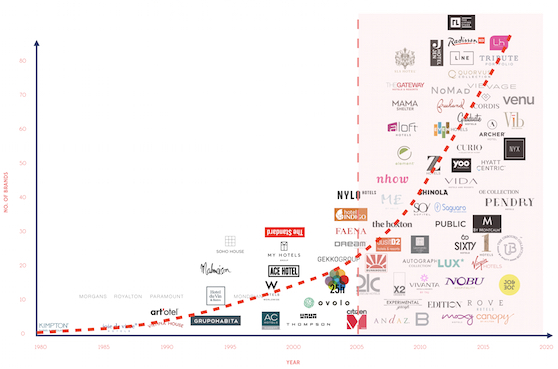In his recent post, “More hotel brands – really?”, HOTELS blogger and hospitality consultant Daniel Lesser bemoans the proliferation of the new – mainly soft – hotel brands purportedly answering the chains’ insatiable need for growth.
Without doubt, the sector is overly segmented, but we should also recognize that the mushrooming of brands of the past 10 years has been driven mainly by the so-called lifestyle category.
More significant than the sheer number of these new and more accessible brands, from Ace to Z Hotels, which have been driven by younger, tech-savvy millennials, is that very little differentiates them. They may be distinguishable from their legacy siblings but they are almost identical to one another.
Recently, we’ve been analyzing the profile, positioning and promotion of 81 of these new brands in conjunction with their dates of introduction, and a series of fascinating correlations have emerged.
Look, for instance, at the taglines employed by lifestyle brands, and the lack of differentiation becomes apparent. A significant proportion of the slogans employ similar sound bites, such as “designed for the modern traveler” (Vivanta by Taj), “hotels designed for the modern traveler’ (Nylo Hotels), “created for a new generation of travelers” (Freehand Hotels) and “unique hotels for unique travelers” (Hyatt Centric). This is buzzword bingo at its best!
Under the surface
Whether to emulate or obscure the propositions of one another, these brands have failed to carve out a distinct identity, an omission that becomes concrete when you step inside their properties. Here, you are surrounded by a largely derivative set of what we term “spray-on” concepts: hotels that may appear different superficially but that are essentially the same when you scratch the surface.
Even when presentation and design differs, the core ingredients are the same:
- Design that reflects the unique community and culture of the area
- High-tech – or all-tech – approach
- A high-energy social environment
- Amenities that cater to Gen Y’s desire for healthy, authentic experiences
Lesser pleads for an end to “the introduction of confounding new hotel brands” and calls for the industry to focus instead on “bolstering and reinforcing existing brands,” but the burgeoning bandwagon of new brands will not slow anytime soon.
As of June 2017, there are more than 100 lifestyle brands, a number that has grown dramatically from 2007. Figure 1 plots the upward trajectory of the 81 brands we studied. As the recent New York opening from Ian Schrager (Public Hotel) and announcements from Trump (American Idea) and Wyndham (Trademark) attest, there’s little indication of a plateau being reached.

The chart also demonstrates the clear correlation between growth in millennial spending power and the proliferation of lifestyle brands. As the first-born millennials turned 25 in 2005, their disposable incomes and corporate budgets increased to the point where they graduated into a viable customer segment. With 92 million millennials in the U.S. alone, the combined spending power of this group will only continue to increase, and well into the middle of the next decade.
Consequently, the lifestyle brands that have already launched are also likely to significantly scale their portfolios over the same period. The 81 brands depicted in Figure 1 have 1,293 properties open and between them project a pipeline of 842 hotels, resulting in a projected hotel expansion of 65% for the lifestyle category alone.
Going generic
The issue is that although these hotel brands are currently on the rise numerically, there will quickly come a point when the promise, look, feel and experience they offer becomes (and is found to be) as generic and bland as the regulation Sheratons, Hiltons and Hyatts they were designed to supersede. From that point, the only way is down.
To prevent falling off the cliff, all new brands but these new brands in particular, must work harder to cultivate genuine points of differentiation between them and not merely from the legacy brands they are replacing.
One way of accomplishing this would be to think harder about purpose. Why should a guest choose you rather than one of the other 80 brands and what can you do for them that nobody else can? Simply being Instagrammable does not a sustainable purpose make.
Piers Schmidt is founder of Luxury Branding, with offices in London and Cape Town.
